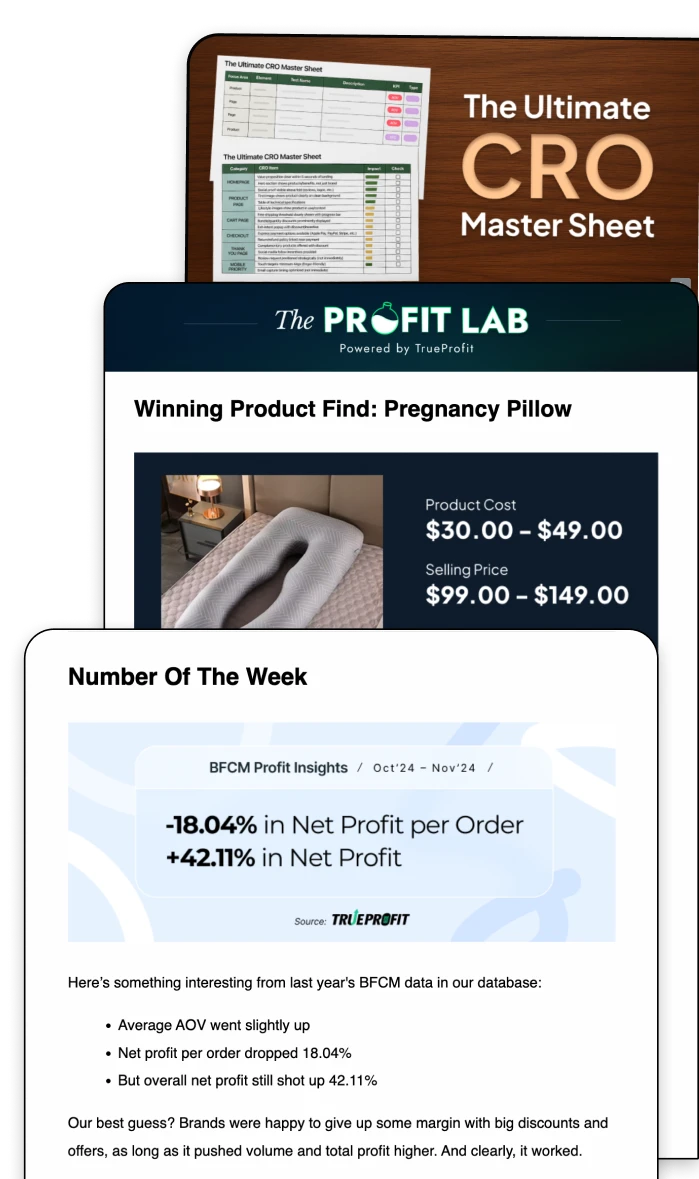How to Calculate Profit Margin on a Product: A Simple Guide

Profit margin is the percentage of profit you make on a product after covering its costs. Learn how to calculate profit margin on a product to see exactly how much you keep from each sale after subtracting what it costs to produce or source it.
In this guide, we’ll walk you through the simple steps to calculate your product’s profit margin. You’ll also see clear examples to help you understand how it works and why it's important for your business.
How to Calculate Profit Margin on a Product
To calculate profit margin on a product, follow these four simple steps:
- Determine the Selling Price: This is how much you sell the product for.
Example: If you sell a product for $100... - Determine the Cost of Goods Sold (COGS): This is the direct cost to produce or acquire the product.
Example: If the cost to produce or acquire the product is $60... - Subtract COGS from the Selling Price to Get Gross Profit:
Formula: Gross Profit = Selling Price - COGS
Example: $100 - $60 = $40 - Divide Gross Profit by Selling Price and Multiply by 100 to Get Profit Margin:
Formula: Profit Margin (%) = (Gross Profit / Selling Price) * 100
Example: ($40 / $100) * 100 = 40%
These steps will give you the percentage of profit you make from each sale.
Example Calculation of Profit Margin
Let’s walk through a simple example to calculate profit margin.
- Selling Price: $150
- COGS: $90
First, subtract the COGS from the selling price:
Then, divide the gross profit by the selling price:
Finally, multiply by 100 to get the profit margin:
So, the profit margin is 40%. This means you keep 40% of each sale as profit.
Why Profit Margin Matters
Profit margin is more than just a number—it’s a vital tool for any business. Here's why it matters:
- Pricing Strategy: Helps you set the right prices to cover costs and increase customer profitablity.
- Cost Management: Allows you to assess if you're managing costs effectively.
- Financial Health: Acts as a key indicator of your business’s overall profit and loss status.
- Sustainability and Growth: Monitoring profit margin helps you make smarter decisions for long-term success.
Types of Profit Margins
There are different types of profit margins, each focusing on different aspects of business costs:
- Gross Profit Margin: This looks at the profit after subtracting only the direct costs of producing a product (COGS).
- Operating Profit Margin: This includes operating costs, like salaries and rent, in addition to direct costs.
- Net Profit Margin: This is the most comprehensive, taking into account all expenses, including taxes, interest, and other costs.
Common Mistakes When Calculating Profit Margin
Calculating profit margin isn’t always straightforward, and small mistakes can lead to inaccurate results. Here are some common mistakes to watch out for:
- Not Accounting for Hidden Costs: Shipping, taxes, and other fees can affect your margin but are often overlooked.
- Confusing Profit Margin with Markup: Profit margin shows your actual profit after costs, while markup is how much you add to your cost to set a price.
- Overlooking Variations by Product: Different products may have different profit margins. Treating them all the same can mislead your overall calculation.
Methods to Calculate Profit Margin (with Comparison)
How to calculate profit margin per product? For this question, you can calculate profit margin using a Google Sheet, an online calculator, or an automatic tool. All three help you get the same result — pick the one that fits your time, skill level, and business size.
Methods | How-to | Pros | Cons |
|---|---|---|---|
Google Sheet/Excel | Use the formula: (Selling Price - Cost) / Selling Price × 100. | Free, flexible, and good for manual control. | Takes a lot of time and the numbers are outdated immediately. |
Online Calculators | Search “profit margin calculator,” enter your numbers, and get results fast. Check out this net profit calculator, for example. | Quick and easy. No setup needed. | Can’t track or save multiple products. |
Automatic Tools | Like TrueProfit, the #1 Net Profit Analytics solution for Shopify sellers. It helps to simplify your profit margin tracking processes, provides real-time insights, and all of TrueProfit's reports surround the most important metrics your business needs to track - net profit. | Saves time, tracks multiple metrics accurately, and always updates in real time. | May require a subscription. |
Knowing how to calculate profit margin on a product is one of those small habits that pays off big over time. It gives you a clearer picture of what you’re really earning—and where there’s room to grow.
Keep your margins in check, and you’ll make smarter, more confident business moves.
Leah Tran is a Content Specialist at TrueProfit, where she crafts SEO-driven and data-backed content to help eCommerce merchants understand their true profitability. With a strong background in content writing, research, and editorial content, she focuses on making complex financial and business concepts clear, engaging, and actionable for Shopify merchants.




 Shopify profits
Shopify profits

